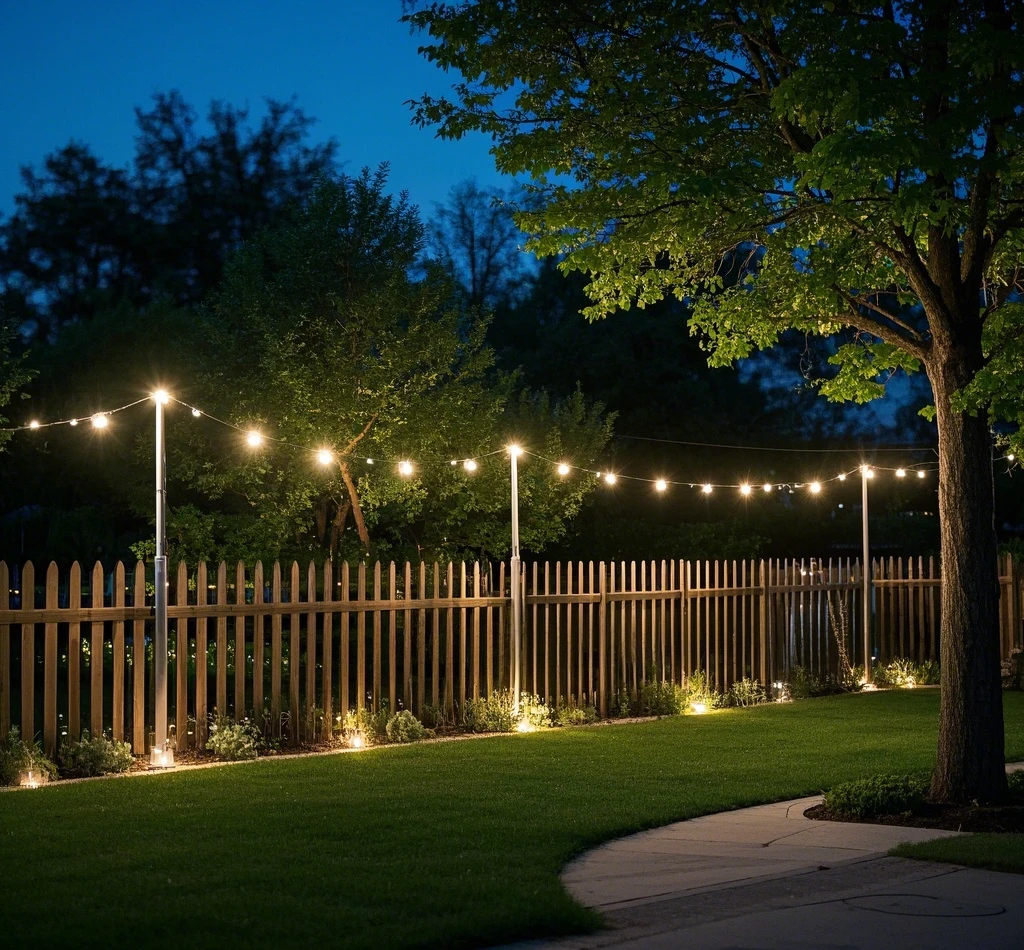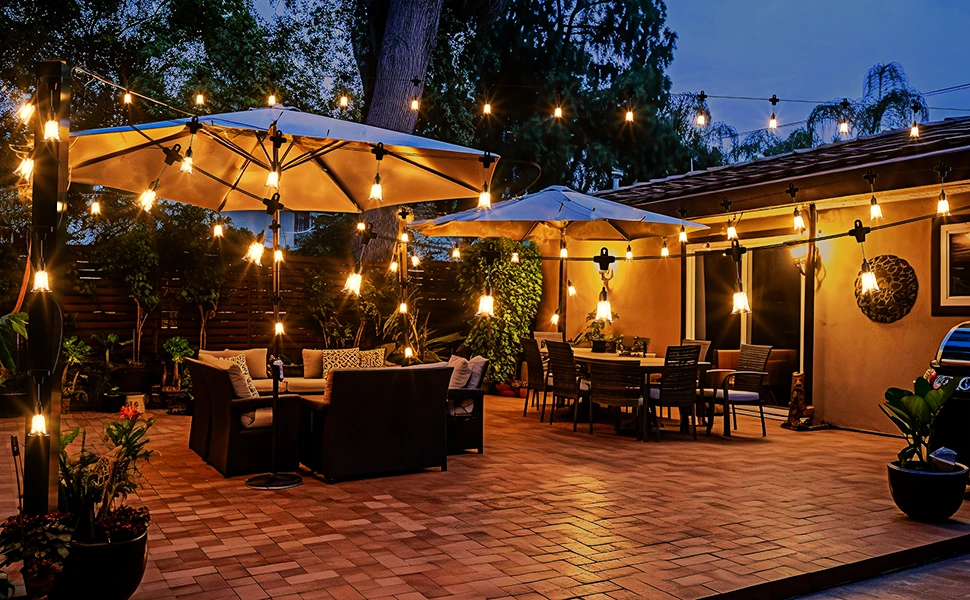Solar string lights are a popular choice for eco-friendly, cost-effective outdoor lighting, transforming patios, gardens, and pergolas with their warm glow. Powered by solar energy, these lights rely on a solar panel and rechargeable battery to illuminate LED bulbs at night. However, users often encounter issues, asking, “Why are my solar string lights not working?” This article explores the common reasons behind this problem, offers troubleshooting steps, and provides practical solutions to restore your solar-powered lights to full functionality, drawing on industry insights and user experiences for a comprehensive guide.

Understanding How Solar String Lights Function
To diagnose why solar string lights aren’t working, it’s essential to understand their components. A solar panel captures sunlight to charge a rechargeable battery, typically lithium-ion or NiMH, which powers the LED bulbs. A light sensor or timer activates the lights at dusk. Issues with any of these components—panel, battery, wiring, or bulbs—can cause malfunctions. Environmental factors, installation errors, or wear and tear also play a role. Let’s explore the most common reasons for solar string light failures and how to address them.
Common Reasons Solar String Lights Stop Working
Insufficient Sunlight or Poor Solar Panel Placement
The solar panel needs direct sunlight to charge the rechargeable battery effectively. If it’s placed in a shaded area, under trees, or near buildings, it may not receive enough solar energy. A 2023 article from The Spruce noted that solar string lights require 6–8 hours of direct sunlight for a full charge. Cloudy weather, short winter days, or dirt on the panel can further reduce charging efficiency, leading to dim or non-functional lights.
Solution: Reposition the solar panel to a location with maximum sunlight exposure, ideally facing south in the Northern Hemisphere. Clean the panel regularly to remove dust, leaves, or bird droppings. A 2024 Reddit discussion in r/solar suggested tilting the panel to match the sun’s angle for better efficiency, especially in low-light seasons.
Battery Issues
The rechargeable battery is a common culprit when solar string lights fail. Over time, batteries degrade, losing their ability to hold a charge. NiMH batteries, often used in solar-powered lights, may last 1–2 years, while lithium-ion batteries can last longer but still degrade. A 2023 SolarReviews guide highlighted that a weak battery might not store enough energy, causing lights to flicker or not turn on at all.
Solution: Check the battery for corrosion, leaks, or swelling, and replace it if needed. Most solar string lights use standard AA or AAA NiMH batteries, but confirm the specifications. If the lights have a USB charging option, use it to test if the battery is the issue. Upgrading to high-capacity lithium-ion batteries can improve performance.
Faulty or Damaged Solar Panel
A cracked, dirty, or malfunctioning solar panel can prevent charging, rendering the lights inoperable. Damage from weather, impacts, or manufacturing defects can reduce the panel’s efficiency. A 2024 EnergySage article noted that even small cracks can disrupt the electrical flow, causing the rechargeable battery to remain uncharged.
Solution: Inspect—The solar panel for visible damage, such as cracks or discoloration. Test it by placing it in direct sunlight and checking if the lights work after a few hours. If the panel is faulty, replace it with a compatible model from the manufacturer. Ensure the panel has an IP65 rating or higher for durability in outdoor lighting conditions.
Wiring or Connection Problems
Loose or damaged wiring between the solar panel, rechargeable battery, and LED bulbs can disrupt power flow. Outdoor exposure to rain, wind, or pests can fray wires or loosen weatherproof connectors. A 2023 Bob Vila review pointed out that rodent damage is a common issue for solar string lights installed in gardens, leading to short circuits or complete failure.
Solution: Inspect the wiring for frays, cuts, or chew marks. Secure loose weatherproof connectors and replace damaged sections if possible. For IP65-rated solar lights, ensure all connections are sealed to prevent moisture ingress. If the wiring is integrated, consider replacing the entire string.
Defective LED Bulbs or Light Sensor
While LED bulbs are durable, they can burn out or become defective, especially in low-quality solar string lights. A single faulty bulb can disrupt the circuit in series-wired strings, causing all lights to fail. Additionally, a malfunctioning light sensor may prevent the lights from turning on at dusk. A 2024 post on Bitpott noted that dust or debris on the sensor can mimic daylight, keeping the lights off.
Solution: Test each LED bulb by replacing it with a known working bulb, if the design allows. For non-replaceable LEDs, contact the manufacturer for a replacement string. Clean the light sensor with a soft cloth to ensure it detects darkness accurately. If the sensor is faulty, a replacement unit may be needed.
Incorrect Settings or Modes
Many solar string lights offer multiple modes, such as steady, flashing, or dimming, controlled by a switch or remote. Incorrect settings or a stuck switch can make the lights appear non-functional. A 2023 Houzz article mentioned that users often overlook mode settings, assuming the lights are broken when they’re simply off or in a low-brightness mode.
Solution: Check the mode switch on the solar panel or battery compartment. Cycle through the settings to ensure the lights are set to “on” or the desired mode. If the lights have a remote, replace its battery or test it for functionality.

Environmental and Installation Factors
Environmental conditions and improper installation can also cause solar string lights to stop working. For example:
- Extreme Weather: Prolonged exposure to heavy rain, snow, or extreme heat can damage components. IP65-rated solar lights are better equipped for harsh conditions, but even these can fail if submerged or overheated.
- Improper Installation: Overstretching the string or placing the solar panel in a poorly lit area can lead to performance issues. A 2024 CPSC report noted that improper strain relief in decorative lighting can damage wires, a risk applicable to solar string lights.
Solution: Ensure the lights have an appropriate IP65 rating for outdoor use. Install them with clips or hooks to avoid tension on the wires. Relocate the solar panel if it’s not receiving adequate sunlight.
Troubleshooting Steps for Solar String Lights
To systematically diagnose why your solar string lights aren’t working, follow these steps:
- Check Sunlight Exposure: Ensure the solar panel is in direct sunlight for 6–8 hours. Clean it to remove any debris.
- Test the Battery: Remove the rechargeable battery and test it with a multimeter or replace it with a new one. Charge via USB if available.
- Inspect the Solar Panel: Look for cracks or damage. Test in bright sunlight to confirm charging.
- Examine Wiring and Connectors: Check for loose or damaged weatherproof connectors and wires. Secure or replace as needed.
- Verify LED Bulbs and Sensor: Test individual LED bulbs and clean the light sensor. Replace faulty components.
- Review Settings: Confirm the lights are set to the correct mode and the switch is functional.
If these steps don’t resolve the issue, contact the manufacturer for warranty support or consider replacing the unit. A 2023 Department of Energy guide emphasized the importance of choosing solar-powered lights with clear warranty terms to address defects.
Preventive Maintenance for Solar String Lights
To avoid future issues with solar string lights, adopt these maintenance practices:
- Regular Cleaning: Clean the solar panel monthly to ensure optimal solar energy absorption.
- Battery Checks: Replace rechargeable batteries every 1–2 years or when performance declines.
- Proper Storage: Store lights indoors during off-seasons to protect them from extreme weather.
- Quality Purchases: Choose solar string lights with UL 588 or CSA C22.2 NO. 37-20 certifications for reliability and safety.
- Secure Installation: Use proper mounting to prevent wire strain or damage from wind or animals.
A unique tip from a 2024 Bitpott discussion involves using a portable solar panel with a USB output to charge solar string lights during cloudy periods, ensuring consistent performance in low-light conditions.
When to Replace Solar String Lights
If troubleshooting fails, it may be time to replace your solar string lights. Signs that replacement is necessary include:
- Persistent failure after testing all components.
- Visible damage to the solar panel or wiring that cannot be repaired.
- Batteries that no longer hold a charge, even after replacement.
Investing in high-quality solar-powered lights with robust components, such as IP65-rated designs and lithium-ion batteries, can prevent recurring issues and extend lifespan.
Creative Workarounds for Non-Working Lights
If your solar string lights aren’t working but you’re not ready to replace them, consider these creative solutions:
- USB Charging: Use a USB charger to bypass a faulty solar panel if the lights support this feature.
- Hybrid Setup: Pair solar string lights with battery-powered or plug-in lights for consistent illumination.
- Repurpose: Use non-functional strings as decorative elements during the day, wrapping them around trellises or fences.
Conclusion
When your solar string lights stop working, the issue often stems from insufficient sunlight, battery degradation, faulty wiring, or defective components. By systematically troubleshooting the solar panel, rechargeable battery, LED bulbs, and connections, you can identify and fix the problem in most cases. Regular maintenance, proper installation, and choosing high-quality solar-powered lights with IP65 ratings can prevent future issues. With the right approach, your solar string lights can continue to provide beautiful, eco-friendly outdoor lighting for your home or events, powered by sustainable solar energy.


Leave a Reply